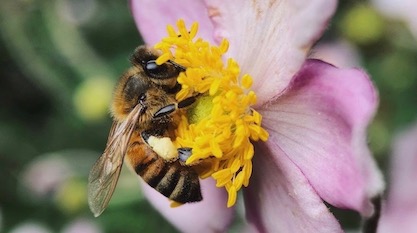 Intelligent Design
Intelligent Design
ID-Friendly Biomimetic Research Continues Apace


According to a 2006 paper in the Royal Society Interface, the word “biomimetics” was coined by Otto Schmitt in 1950s, but made its first use in a scientific paper in 1969. Five years later it entered Webster’s Dictionary. The definition is:
The study of the formation, structure, or function of biologically produced substances and materials (as enzymes or silk) and biological mechanisms and processes (as protein synthesis or photosynthesis) especially for the purpose of synthesizing similar products by artificial mechanisms which mimic natural ones.
The Bionic Woman
Schmitt preferred his term over bionics, a word coined by Jack Steele in 1960 at a U.S. Air Force base in Ohio, which he defined as “the science of systems which have some function copied from nature, or which represent characteristics of natural systems or their analogues.” The two words sprang from similar concepts, but biomimetics sees broader use in scientific papers about all kinds of biological designs, whereas bionics has most often been used in connection with implants to give humans additional powers, as in The Bionic Woman (1976-1978). Other synonyms have been in use, such as biomimicry, “the mimicking of life using imitation biological systems,” or bio-inspiration. Whatever term is preferred, they all rely on the idea that biological systems are so good, they are worth imitating.
A Token Nod to Evolution
Research papers on biomimetics rarely mention evolution. When they do, they include a token reference like, “Evolution has perfected this mechanism through millions of years of trial and error” but never explain how. Such papers also rarely show the artificial designs being superior to the biological designs, except sometimes in certain particulars. Biological designs, of course, must work within the environmental habitat of the creature, and that usually requires tradeoffs with other design constraints. Additionally, they need to be programmed in DNA and able to reproduce themselves. In those respects, the biological designs are always vastly superior. Try getting an artificial RoboFly to lay eggs and make copies of itself!
Recent Illustrations
Here are some recent examples of biomimetics research. Notice the variety of biological sources of inspiration, and the international interest in biomimetics.
Biological inspiration: Insects, specifically halteres on dipteran flies
Design: Motion sensing, gyroscopics
Applications: Gyroscopes for aircraft and submarines
Lab: Oak Ridge National Laboratory
Paper: Lavrik and Datskos, Microsystems & Nanoengineering
Reference to evolution? No
Biological inspiration: Bacterial flagella, lipid microdroplets; chemotaxis
Design: Rapid transport via nano vehicles
Applications: Drug delivery, cancer treatment vehicles that evade immune system
Lab: EU Research & Innovation
Reference to evolution? Just one; “Over billions of years nature has perfected ingenious ways for biological cells to move around their environment and harmlessly transport packages of chemicals between one another.”
Biological inspiration: Honeybee
Design: “RoboBee” powered by soft muscles
Applications: Robotic flyers for environmental monitoring and navigation in confined spaces.
Lab: Harvard Microbiotics Laboratory (see video)
Paper: Nature
Reference to evolution? No.
Biological inspiration: Jumping spiders
Design: Depth sensing
Applications: microrobotics, augmented reality, wearable devices.
Lab: Harvard John A. Paulson School of Engineering
Paper: Proceedings of the National Academy of Sciences
Reference to evolution? One, “Evolution has produced vision systems that are highly specialized and efficient, delivering depth-perception capabilities that often surpass those of existing artificial depth sensors.”
Biological inspiration: Spider silk
Design: Modified spider silk proteins
Applications: Synthesis of “novel highly stable biomaterials.”
Lab: Johannes Gutenberg University of Mainz
Paper: Nature Communications
Reference to evolution? Six, mostly in regard to microevolution. Primary quote: “Over hundreds of millions of years spiders evolved the construction of silk webs of different geometries tailored for various purposes including prey capture, reproduction and shelter.”
Biological inspiration: Human thermoregulation
Design: Heat dissipation
Applications: Mechanical cooling systems for cars, computers
Lab: Drexel University
Paper: International Journal of Heat and Mass Transfer
Reference to evolution? Two: “mimicking the body’s evolution-optimized cooling system,” and “a trick that took Mother Nature more than a few evolutionary cycles to perfect.”
Biological inspiration: Sunflowers, heliotropism
Design: Orienting to the sun
Applications: Improving efficiency of solar cells
Lab: Arizona State, University of California (see Phys.org and videos)
Paper: Nature Nanotechnology
Reference to evolution? Not found.
Biological inspiration: Fungi with exploding spores
Design: Nano-cannon imitating the fungus
Applications: “Biomimetic cannon” built to learn about the mechanism
Labs: Three universities in Denmark; explanation in Phys.org
Paper: Royal Society Interface
Reference to evolution? No.
On a Roll
Biomimetics is still on a roll after decades, with no sign that researchers are tiring of it or running out of biological designs to be inspired by. Though some articles and papers give a brief nod to evolution, it is usually as a statement of faith rather than a source of empirical, testable support for the research. The field of biomimetics is all about design, engineering, and usefulness of nature’s ingenuity.
Photo: A honeybee, by Aaron Burden via Unsplash.
